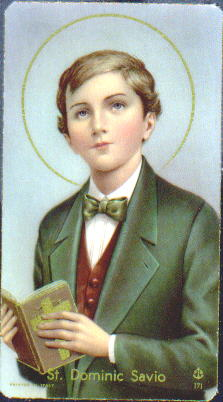St. Dominic Savio
I’m going to try to put some of the informational materials that we use for DTS here in this section. Often these are from other websites on the Internet.
Later I will try to write a brief on what we taught about that saint. I will try to attribute any material I use to the actual authors whenever available.
Here is some information we took from the Salesian’s Web page to teach about St. Dominic Savio.
Saint Dominic Savio

——————————————————————————–
With much truth, St. Dominic Savio has been often described as the pedagogical masterpiece of St. John Bosco. It is not a statement with which one could readily quarrel. Emile was similarly described as the pedagogical masterpiece of Jean Jacques Rousseau. But what a difference there is between the two! Emile was merely a fictitious paper character, living his life within the pages of a book. Dominic Savio, on the other hand, was a reality, living in the flesh.
He grew up a child among children – an adolescent among adolescents. Then, already ripe for heaven, he died in the fame of sanctity when he was hardly fifteen years of age.
It must be admitted, when he entered the Oratory of Don Bosco, he was already docile to grace. His heart was pure and he was already disposed to die rather than offend God by sin. He was born, in 1842, of a poor family at Riva di Chieri, near Turin. Such was his youthful piety, that he was granted the exceptional privilege of making his First Holy Communion when he was only seven. The normal age at that period was twelve.
A child he was still in years, but when one reads the resolutions put down in his own handwriting to mark the occasion, it is easy to see how adult in will he already was.
Outstanding among the resolutions is that which he took for the motto of his life: “Death but not sin!”
All who had any dealings with him in his early years – his parents, his parish priest, his teachers and his companions – all testified to his extraordinary candor and sincerity. To this, they tell us, was allied an amazing capacity for rendering good for evil, even in the smallest things.
When the blame was put upon him by another lad for something which he had not done, he made no effort to defend or excuse himself. Afterwards, when asked by his teacher why he had not declared his innocence, the answer was worthy of one already so immersed in the ways of God. “That boy had already been found guilty of other faults, so, for this one he would very likely have been expelled from school. As for myself, since it was the first offence of which I had been accused, I hoped I might be forgiven.” An he added the telling remark: “Besides, I thought of Our Divine Savior who was unjustly accused.”
When Don Bosco welcomed Dominic to the Oratory, he was quick to admit that his new pupil was ‘good stuff’. With that simple, uninhibited trust that was so characteristic of him, Dominic asked the Saint: “What can you do with this ‘stuff’?” And Don Bosco told him that, with it, could be made a lovely garment for Our Lord. There was no hesitation. Dominic’s reaction was instant: “Very well, then. I’ll be the cloth; you be the tailor!”
Don Bosco was among the first educators to recognize the importance of work. Daily work, regularly and conscientiously performed was a sure stepping-stone to sanctity. The schools which he opened for the teaching of arts and trades to poor boys had a two-fold aim. They were certainly to help boys to equip themselves to take employment and to earn a living. But that was not all. The boys were taught to see how God could be served and their own lives sanctified.
Generations of lads in the Salesian schools of arts and trades and in other types as well, have learned, thanks to Don Bosco and his sons, the love of work conscientiously done and its value for heaven.
Young Dominic Savio has been acclaimed by the Church as the perfect model and fruit of Salesian education.
Calm, cheerful, cordial, lovable and always affable, even in the midst of suffering and mortification, he was a model for his companions. They idolized him and he exercised his influence with them to keep them from evil and to draw them towards all that was beautiful, upright and good. His gentleness won them. With the grace that was in him he conquered them.
His had the knack of being able to reprove without giving offence, and to admonish without humiliating. When he was still only twelve, he knew well that he had not long to live. He remained at the Oratory only three years. His health was so frail that he could no longer keep up with the daily round of study and work. And so, with real regret, it was decided to send him home to be cared for by his family.
Though he was aware that the news was really a sentence of death, he took it with his usual calm. “Au revoir,” he called to his friends, “until we all meet again in God’s company.”
Dominic Savio was Don Bosco’s masterpiece and would not be lost.
It was March 9, 1857 when the first flower of the Salesian Oratory unfolded its blossom in heaven in the glory of the Saints. Dominic was canonized a Saint on June 12, 1954 by Pope Pius XII.